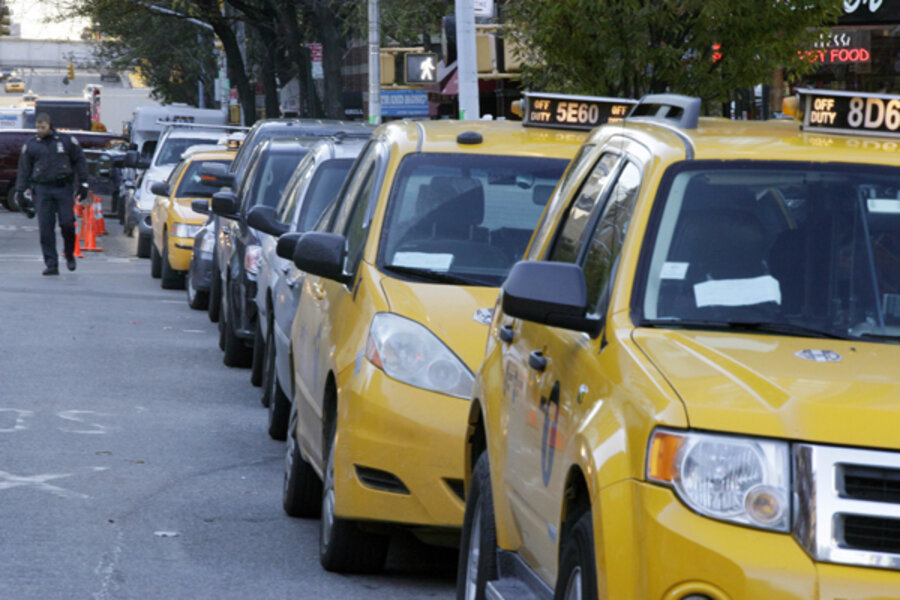Gas rationing begins in New York City and Long Island as some power returns
Loading...
| New York
A gasoline rationing plan that lets motorists fill up every other day went into effect in New York on Friday morning, as utility crews made some progress erasing outages that put thousands of new homes and businesses in the dark in a region still reeling from Superstorm Sandy.
Police enforced the new system at filling stations in New York City and on Long Island as drivers turned out before dawn to line up for their rations. At a Hess station in the Hell's Kitchen neighborhood of Manhattan, drivers said it appeared to be working so far.
Luis Cruz, 35, of the Bronx, gassed up the Dodge minivan he uses as a pet chauffeur.
"It's a lot better," Cruz said. "A couple of days ago I waited four hours. They should have done this a long time ago."
The line to the station was just a block and a half long Friday morning, and customers said they waited about 15 minutes. Last week, some lines stretched for a mile or more.
"This is designed to let everybody have a fair chance, so the lines aren't too oppressive and that we can get through this," Mayor Michael Bloomberg said Thursday.
Only a quarter of the city's gas stations were open, the mayor said. Some were closed because they were out of power, others because they can't get fuel from terminals and storage tanks that can't unload their cargo.
Near a still-closed auto tunnel linking Manhattan and Brooklyn early Friday, cab and delivery truck drivers — exempt from the rationing system — eyed with dismay a line of closed gas stations.
"Hey, when's the gas coming?" one driver hollered, to honking horns. "Tomorrow, we hope," the attendant replied, shrugging his shoulders.
The nor'easter brought gusting winds, rain and snow on Wednesday and early Thursday before it moved on. Snow blanketed several states from New York to New England and stymied recovery efforts from Superstorm Sandy as additional storm-weakened trees snapped and more power lines came down.
Thousands of utility customers, mostly in New York and New Jersey, have been left waiting for their electricity to come back on — and some are losing patience, demanding investigations of utilities they say aren't working fast enough.
An angry Gov. Andrew Cuomo joined the calls for an investigation Thursday, ripping the utilities as unprepared and badly managed.
"It's unacceptable the longer it goes on because the longer it goes on, people's suffering is worse," he said.
Cuomo appears to be all by himself among the New York area's big three politicians. Bloomberg defended the city's power company, Consolidated Edison, and said it has done a good job in recent years. And New Jersey Gov. Chris Christie praised the utilities, saying he expects all of his state to have power back by early Sunday.
The utilities have said they are dealing with damage unprecedented in its scope and are doing the best they can. And there is no denying the magnitude of what they have done: At the peak, more than 8.5 million homes and businesses across 21 states lost power during Sandy.
Early Friday, there were more than 220,000 outages left in the New York area, mostly on Long Island, and about 250,000 in New Jersey. Almost all Connecticut residents had lights again, down from 625,000 at the storm's height.
Still, some people have lived for days in the dark in temperatures near freezing.
"We lost power last week, just got it back for a day or two, and now we lost it again," said John Monticello, of Point Pleasant Beach, N.J. "Every day it's the same now: turn on the gas burner for heat. Instant coffee. Use the iPad to find out what's going on in the rest of the world."
The mounting criticism of utility companies came as the Federal Emergency Management Agency started bringing mobile homes into the region and Cuomo said the storm could cost New York State alone $33 billion.
New Jersey did not have a damage estimate of its own, but others have put Sandy's overall toll at up to $50 billion, making it the second most expensive storm in U.S. history, behind Hurricane Katrina, which swamped New Orleans in 2005.
In New York City and Long Island, the gas rationing followed New Jersey's lead nearly a week ago in a move meant to deal with fuel shortages and long lines at gas stations.
Officials said something had to be done to ease long waits for fuel, which they say has caused panic-buying and hoarding. The system took effect at 5 a.m. Friday on Long Island and at 6 a.m. in New York City.
Gas is available to drivers with license-plate numbers ending in an odd number or a letter on Friday. On Saturday, drivers with license plates that end in even numbers or zero can fuel up.
Buses, taxes and limousines, commercial vehicles and emergency vehicles are exempt from the plan, as are people carrying portable gas cans. Vanity plates that don't have numbers are considered odd-numbered plates. Out-of-state drivers are also subject to the system.
Bloomberg said the shortages could last another couple of weeks.







